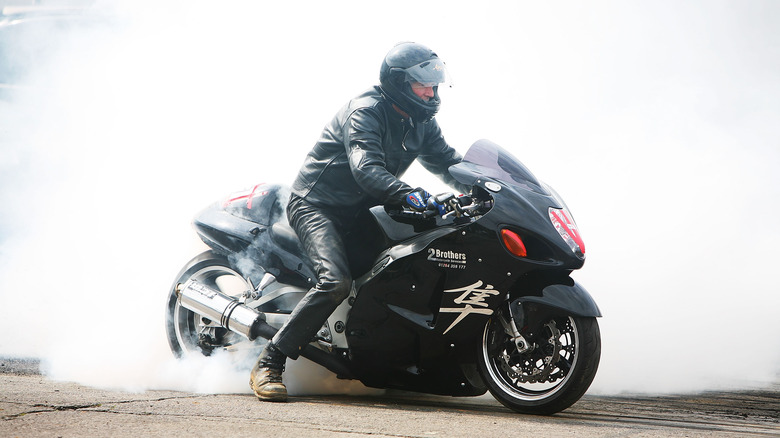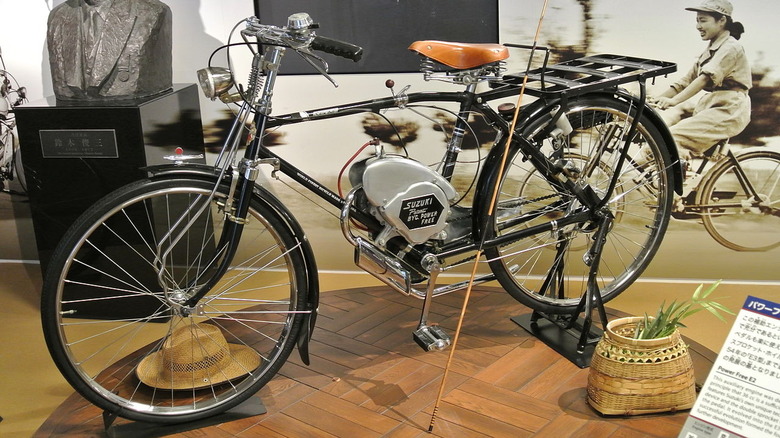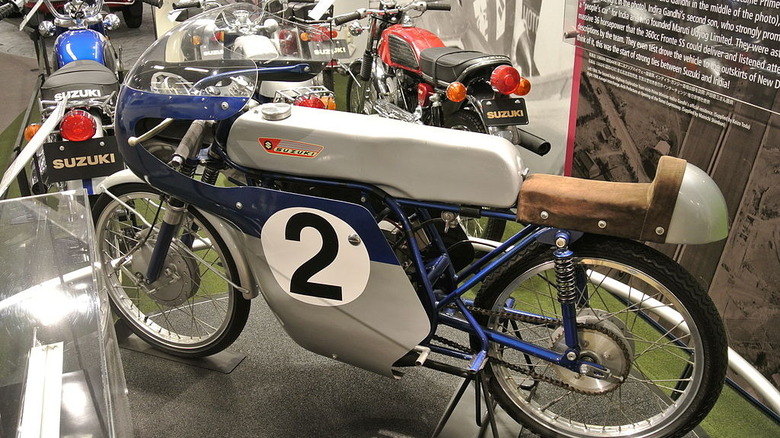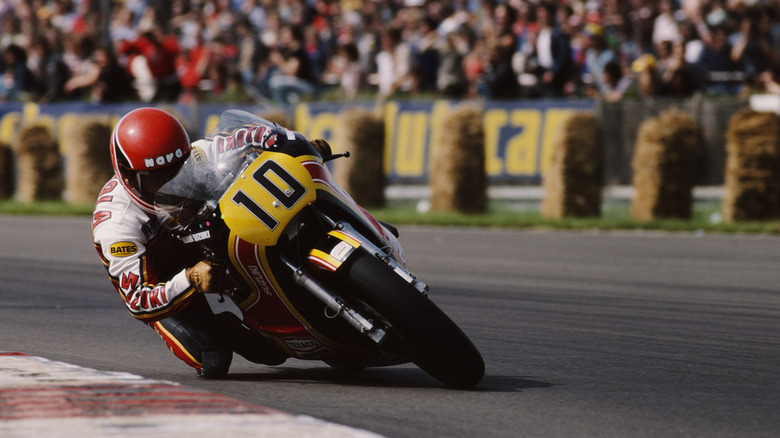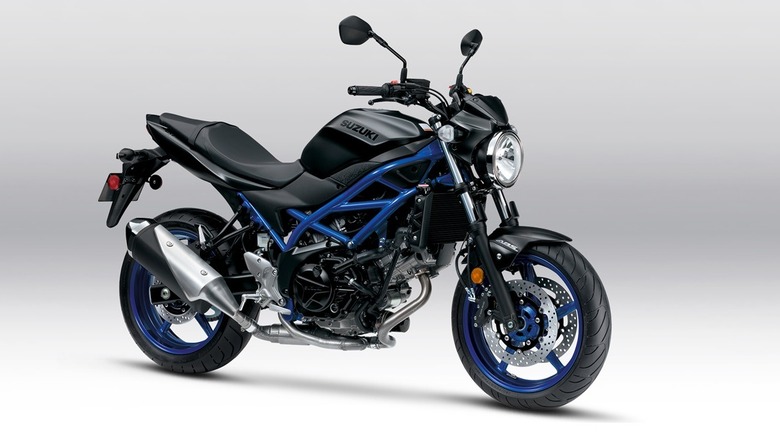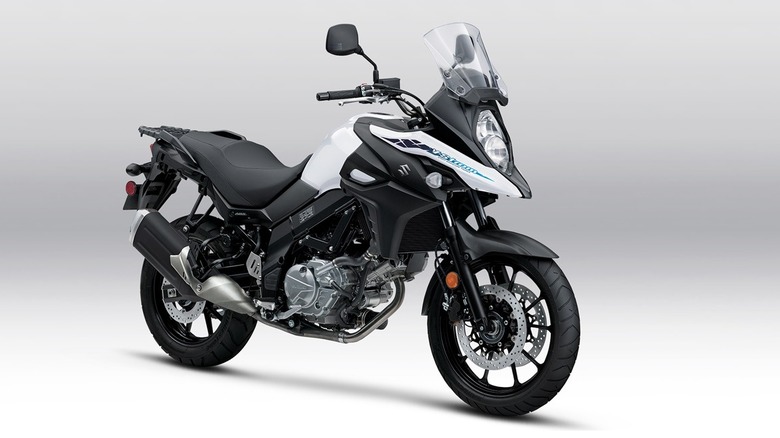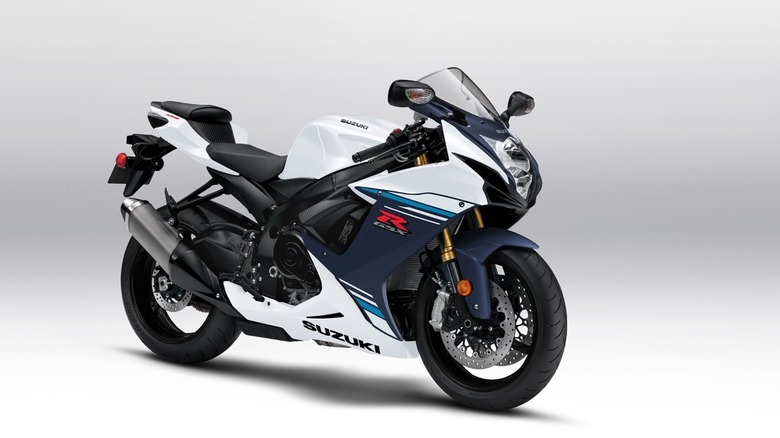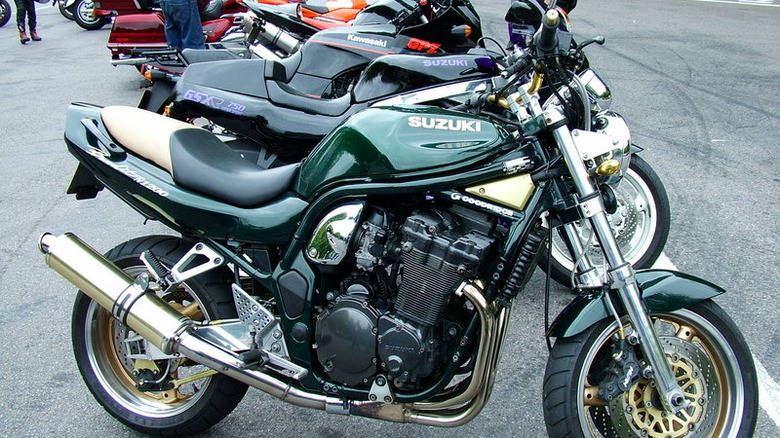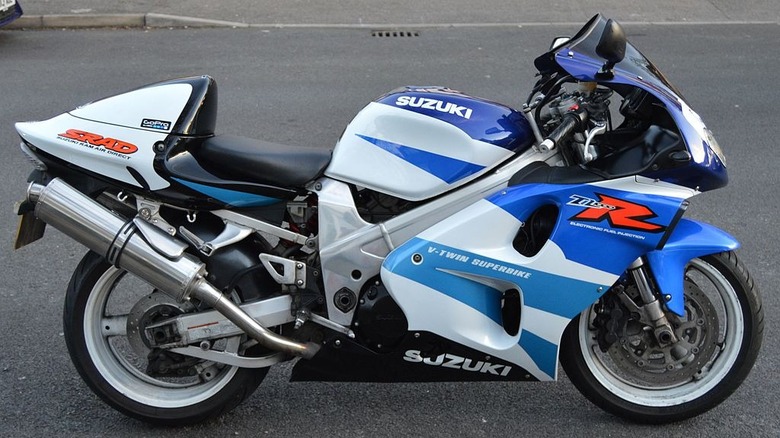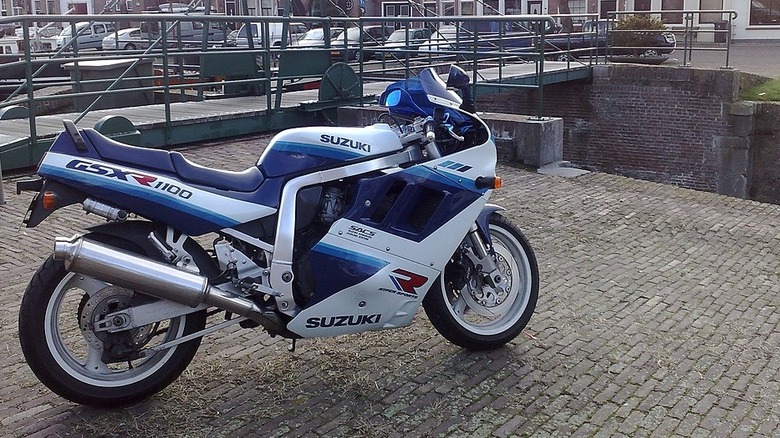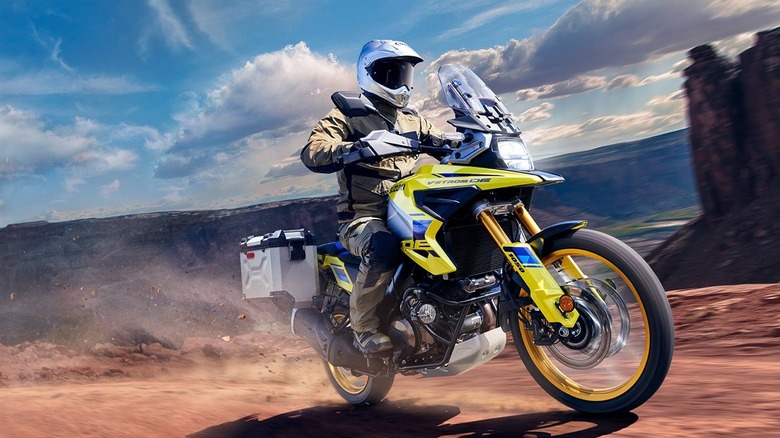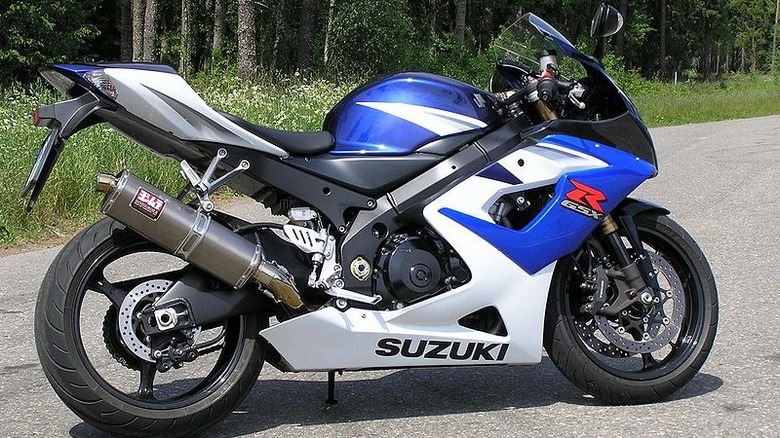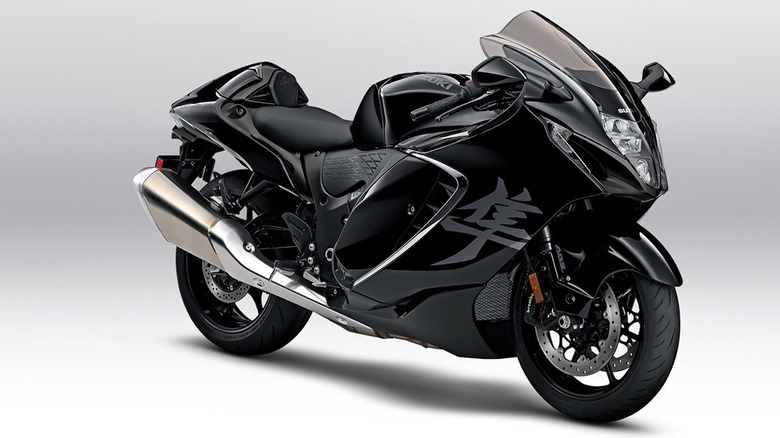The 12 Best Suzuki Motorcycles Ever Made
While perhaps not as iconic as Japanese market leader Honda, Suzuki has a rich history of motorcycle manufacture that dates back over 100 years. Founded in 1909 by Michio Suzuki, the Hamamatsu-based marque produces a wide range of motorcycles for various segments, including sports bikes, cruisers, touring bikes, and dual-sport bikes.
Some of Suzuki's most popular models include the GSX-R series of sports bikes, the Boulevard cruiser series, the V-Strom series of dual-sport bikes, and the Hayabusa, a sports bike known for its high performance and a top speed that exceeded that of any roadgoing production motorcycle before it. The company also has a strong racing heritage and has had success in various forms of motorcycle racing, including MotoGP, motocross, and endurance racing.
As an automobile manufacturer, Suzuki is a major global player, having routinely sold over 2.5 million vehicles per year since 2015, and its motorcycle division sold over a million units in the first seven months of 2022 alone. This suggests they have plenty of coffers for motorcycle research and development, and with luck, we should continue to see many new and innovative models in the future. Here we look at this diverse company's past with some of the most influential machines to roll off its production line and why they qualify as the best Suzuki motorcycles ever made.
Suzuki Power Free
Suzuki had humble beginnings, having first been established as a weaving company that automated the manufacturing process and made workers' lives easier. Soon after World War 2, the company diversified, and by the early 1950s, inspired by the need to make commuting easier, company director Shinzo Suzuki turned his attention to powered bicycles. This project was realized in 1952 with the creation of the Suzuki Power Free. Little more than a bicycle with a tiny 36-cc Suzuki engine, this modest machine introduced the Suzuki brand to the public.
While it was certainly primitive, both in concept and design, the Suzuki Power Free did have some worthy patents that would fuel inspiration for motorcycles to come. These included a multi-disc wet clutch as part of its two-speed transmission. While the Power Free didn't exactly set the world alight when it came to sales volume, it set the wheels in motion (pun intended) for a requirement for larger-capacity vehicles, starting with the Diamond Free, its 1953 successor. Fast-forward ten years and the Suzuki motorcycle company had already claimed its first competitive victory, so while the Power Free was indeed modest, it was the spark that ignited the millions of combustion engines that followed.
[Featured image by Rainmaker47 via Wikimedia Commons | Cropped and scaled | CC BY-SA 3.0]
Suzuki RM-62
Having started racing internationally in 1960, Suzuki was all set to compete in the notorious Isle of Man TT, where riders compete at break-neck speed around a street circuit made up of small country lanes (a tradition that continues to this day). Suzuki's 1962 entrant was the Suzuki RM-62, ridden by the East German defector Ernst Degner.
With its awkward styling and hobby horse seat, this was possibly one of the worst-looking machines ever to ride the hallowed Isle of Man TT circuit, but the RM-62 was fast, outpacing the competition and cruising to victory, having completed the two-lap 75.46-mile race with an average speed of over 75 miles per hour.
The world championship-winning RM-62 was all the more impressive, given its small engine capacity of just 50cc. While it competed against much larger 125cc machines, its success lay in its being extremely lightweight, with its tiny 8-horsepower two-stroke block pushing it to 90 miles per hour in the right conditions. Like the Power Free before it, this somewhat unremarkable machine set the standard for the many two-stroke racing successes that Suzuki enjoyed in the years to follow.
[Featured image by Rainmaker47 via Wikimedia Commons | Cropped and scaled | CC BY-SA 3.0]
Suzuki RG500
By the 1970s, Suzuki was struggling to compete with its rivals in Moto GP, but it soon had a change in fortune, thanks in large part to the Suzuki RG500. Ridden by motorcycle racing legend Barry Sheene, the initial version of this two-stroke wonder brought Suzuki back into the motor racing limelight, winning four 500cc World Championships in 1976 and 1977 (by Sheene), and again in 1981 and 1982. Motor racing was experiencing its heyday in the mid-1970s, with sporting stars such as Sheene and his Formula One equivalent, James Hunt, dominating the headlines both on and off the track. This served to create great public interest in motorsport in general, and the machines that were piloted by these skilled and often controversial figures deserved equal praise.
The original RG500 sported a square four-cylinder 500cc, two-stroke, water-cooled engine with a six-speed transmission that originally created 90 brake horsepower (increasing to 150 bhp in later years). Such was the success of this bike on the track that Suzuki released a street-legal version, the RG500 Gamma, in 1985. This road rocket was comparable to its track-based predecessor but had upgraded faring and essential roadgoing additions, such as headlights. It achieved a standing quarter mile in just over 11 seconds and topped out at around 147 miles per hour.
Suzuki SV650
Naked bikes or "Streetfighters" have been highly popular ever since the late 1980s, when riders removed the bulky faring of their (often race-damaged) sport bikes, leaving the stripped-down bare essentials and a lot of frame on display. Nowadays, this has become a style in its own right, with many top brands creating their own purpose-built mid-sized naked bikes such as the Yamaha MT-07 and the Kawasaki Z650. Suzuki answered the call in 1999 with its Suzuki SV650.
The SV650's mid-size 645cc V-twin isn't too flighty, offering up to 75 horsepower, making it manageable even at higher revs. Features include an aesthetically-pleasing trellis steel frame, a six-speed gearbox, dual front disc brakes with optional ABS, and aluminum alloy 17-inch wheels.
The SV650 is well-respected by both critics and the road-going public as a competent machine that excites and performs in equal measure and is suitable for beginners and accomplished riders alike. Whether you are a daily commuter, a sport rider, or a weekend tourer, this bike has something to offer, and at a very reasonable price, so it's no wonder that it has continued to evolve since the turn of the century, with re-releases each subsequent decade.
Suzuki V-Strom 650
The Suzuki V-Strom 650 is the brand's mid-weight adventure tourer that has been in production since 2004. Often seen as an entry-level big bike, the V-Strom 650 has plenty to attract even seasoned riders, especially those who prefer a lighter vehicle with off-road ability and enough power to keep pace on the freeway.
The V-Strom 650 is powered by a liquid-cooled, 645cc V-twin engine that produces around 70 horsepower and 68 Nm of torque. With its large 19-inch front wheel, wire spokes, and 6.9-inch ground clearance, it is a capable off-road machine with a comfortable upright riding position, which makes it ideal for long-distance riding. Rider assists come in the form of dual ABS, plus Suzuki's Advanced Traction Control and Easy Start System. These are adjusted via its backlit control panel, although it sadly lacks the TFT display as seen on larger-capacity models.
It is a direct competitor of the Kawasaki Versys 650 and the Triumph Tiger Sport 660, although these are better suited to road-only use, making the V-Strom a favorite among those who require versatility from a mid-sized ADV bike. While Suzuki has larger, better-equipped bikes in this segment, such as the formidable V-Strom 1050DE Adventure, there's an enthusiastic market for the 650, as it marries performance with lightweight maneuverability, comfort, and style.
Suzuki GSX-R750
Few bikes' production runs make it past the quarter-century mark, but the Suzuki GSX-R750 has been highly popular since its introduction in 1985. Longevity aside, it is an affordable, lightweight, high-performance machine that has always looked good with each subsequent release. Commonly used by roadgoing speed demons and track racers alike, the GSX-R750 is considered one of the most popular sports motorcycles in its class.
In its original form, the Suzuki GSX-R750 was ahead of its time. It was perhaps the blueprint on which all Japanese sport bikes were modeled from that moment forward, with its race replica full-faring, oil-cooled four-cylinder engine, lightweight aluminum frame, and powerful engine that produced 100 brake horsepower at 10,500 rpm.
Fast forward to today, and the latest Suzuki GSX-R750 shares some common features with its ancestor, namely the 750cc four-cylinder engine, the four-into-one exhaust, the six-speed, constant mesh transmission, and aluminum frame. Notable differences include ABS brakes, Showa inverted forks, a modern engine management system, rider assists, and a much higher output of 148 brake horsepower. Principally, however, the bike remained the same. As one of Suzuki's most successful bikes ever produced, the GSX-R750 continues to impress as their ultimate mid-sized road rocket that offers a highly satisfying rider experience and character to spare.
Suzuki Bandit 1200
In a similar category to the Triumph Speed Triple, the Suzuki Bandit 1200 delivered on every level. Despite its uncomplicated design and lack of frills, this was a high-performance machine that was also practical, stylish, and, dare we say, comfortable, with a more relaxed riding position than some of its sporty contemporaries. It was released in both naked (the Bandit N), and half-fared versions (the Bandit S), and had many features that Suzuki Bandit aficionados have come to love.
With a production run between 1996 and 2006, the Bandit 1200 had the official name of GSF1200, and it offered a completely different rider experience as compared to its predecessor, the 600cc GSF600. It featured a 1,157cc DOHC inline-four engine, upgraded bodywork, fully electronic instruments, a lowered seat, increased fuel capacity, and a reworked steering and frame design, as well as having almost double the engine capacity.
The Suzuki Bandit 1200's appeal lay in its simplicity, with an unexceptional chassis, basic suspension, and limited frills, but an excellent all-around performance from cornering, to gear shifts, to braking. It was since re-released as the GSF1250 with ABS and a slightly larger engine capacity but may have lost some of its magic in its later incarnation, as the original 1200s are still very much sought after and discussed after all these years.
[Featured image by Reg Mckenna via Wikimedia Commons | Cropped and scaled | CC BY 2.0]
Suzuki TL1000R
In the late 1990s, Suzuki was up against Ducati and Honda in the race-oriented V-twin stakes and had to deliver a competitive model. The result was the TL1000R, which was discontinued after a five-year run, but has retained a loyal following with fans. Powered by a 996cc engine that produced around 148 horsepower and a massive 116 Nm of torque, the TL1000R was known for its powerful engine, race-worthy handling, and aggressive styling.
As a track-ready racing bike, the TL1000R was well-received by riders for its performance capabilities. These were a result of its exceptional V-twin engine producing 106 Nm of torque and 135 horsepower, a lightweight aluminum trellis-style frame, and preload adjustable front and rear suspension with inverted forks, all built around a track-oriented chassis. Its excellent handling was assisted by a steering dampener which alleviated harsh vibration upon accelerating and six-piston Tokico caliper brakes.
The TL1000R was discontinued in 2003 and was not subsequently replaced by another equivalent model. But for all its lack of technical refinement, poor fuel economy, and no discernible real-world practicality, it has retained a niche following, and nowadays, enthusiasts can purchase one of these monsters for as little as $4,000.
[Featured image by RubSub via Wikimedia Commons | Cropped and scaled | CC BY-SA 4.0]
Suzuki GSX-R1100
In the early-1990s, Suzuki was once again up against rivals Honda, but in this case, their segment-dominant FireBlade. The Suzuki GSX-R1100 was the Hamamatsu company's best competitor, and while it never equaled their Japanese rival's machine in sales, this beast carried considerable weight, both figuratively and literally speaking, at a heavy 250 kilograms.
First introduced in 1986, the early models of the GSX-R1100 had 1,052cc air and oil-cooled engines, while the re-released 1994 model featured a liquid-cooled block. This new generation was more evolved than its 1980s counterpart, with a larger engine capacity (increased to 1,074cc), upside-down racing forks, and an upgraded exhaust system, all of which had a positive impact on performance.
The GSX-R1100 was one of the most popular sport motorcycles in its class during its production run but was discontinued in 1999 due to stricter emissions regulations governing motorcycles. It was replaced in 2001 with the GSX-R1000 as Suzuki's flagship liter-class motorcycle. Very successful in its own right, this bike is still in production today but owes a lot to its big brother in terms of specs and features.
[Featured image Jasper via Wikimedia Commons | Cropped and scaled | CC BY-SA 3.0]
Suzuki V-Strom 1050DE Adventure
The Suzuki V-Strom 1050DE Adventure is Suzuki's flagship ADV bike, in direct competition with the KTM 1290 Super Adventure and BMW's industry-leading R1250 GS. As an upgraded version of the 2020 V-Strom 1050 Adventure, it has achieved a loyal following, with many ardent fans around the globe.
The DE in its name stands for "deluxe", as this bike is laden with advanced features that embellish and improve the rider experience, including a 5-inch color instrument panel, keyless ignition, cornering lights, rider alerts, and a full complement of LED lights. Beneath its 20-liter fuel tank is a 1037cc V-twin engine, tuned to offer large amounts of torque at lower revs, which maxes out at 100 Nm. Safety features are abundant, including a motion-tracking braking system that applies the brakes if the bike senses that the rider has lost control and lean-angle sensitive ABS with two sensitivity modes to ensure safe and confident cornering.
Despite being up against some stiff competition, Suzuki nailed it with the V-Strom 1050DE Adventure. They pulled out all the stops to ensure that it not only stands up well against its peers but is a worthy and sought-after machine in its own right that will no doubt continue its production run for some years to come.
Suzuki GSX-R1000 K5
After decommissioning the GSX-R1100, Suzuki needed a top-tier liter-class machine to fill the void it left, and their answer was the GSX-R1000. In 2005, after five successful generations of the GSX-1000 series, we arrived at the Suzuki GSX-R1000 K5, which excelled as a rider-friendly sports bike that was as at home on the street as it was on the racing circuit. It also had power to spare and was known for its superb balance and handling.
In comparison to its predecessor, the K4, Suzuki opted for a lighter, more dynamic machine in the K5, losing two kilograms to arrive at a lightweight 166 kg. It was slimmer through the hips as well, with a reduced-width fuel tank, narrower handlebars, and a slightly lower seat height. The K5 was powered by a 999cc, four-cylinder engine that produced around 185 horsepower and an impressive 118 Nm of torque. While it was light on rider assists, with no traction control and ABS available, it featured a slipper clutch, which allowed for smoother downshifts and improved handling, and an advanced suspension system, including fully adjustable Showa Big Piston forks and fully adjustable link-type rear suspension.
Despite being more geared toward the track than the highway, the K5 was well-received by riders and critics alike for its performance capabilities and refinement, helped, no doubt, by its ability to reach 180 miles per hour in 21.33 seconds. As far as bragging rights were concerned, this was second only to one other Suzuki on the market, one which retains its notoriety to this day, the formidable Hayabusa.
[Featured image Jasper via Wikimedia Commons | Cropped and scaled | Public Domain]
Suzuki GSX1300R Hayabusa
The Suzuki GSX1300R Hayabusa (Japanese for Peregrine falcon) is legendary in biking circles. For a long time, it was the fastest street-legal bike in existence, reaching speeds of over 190 miles per hour (306 km/h). This is the model that started the unofficial production motorcycle speed competition that still runs to this day (currently held by the outrageous Kawasaki Ninja H2R at 249 mph.) Suzuki's flagship sports bike made a profound impact on the motorcycling world when it was first revealed in 1999 and was notorious, from the playground to the motorcycle press.
The Hayabusa is renowned for its incredibly powerful engine, high-performance capabilities, and instantly-recognizable aerodynamic design. It boasts a 1340cc, four-cylinder, liquid-cooled engine that delivers 187.7 horsepower and a staggering 150 Nm of torque. Later versions are loaded with rider aids to help maintain safety and stability at high speeds, including a ten-mode traction control system, a bi-directional quick shifter, an anti-lift control system, an active speed limiter, launch control, and motion tracking braking, to name a few.
What also makes the GSX1300R stand out from the competition is that it is attainable in its pricing at under $19,000 for the 2023 version. Thanks to the Hayabusa, it suddenly became possible to own a record-breaking superbike, keep it in the garage at home, and ride it on the highway, although a certain level of skill would be required to achieve its full potential. While its looks are questionable, with a bulbous faring and highly-aggressive rider position, and it only has seating for one (not that anyone would want to ride on the back), the Hayabusa has remained a contender in a very competitive market for almost a quarter-century. Sometimes, the facts speak for themselves.
